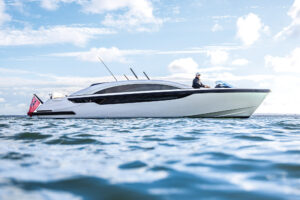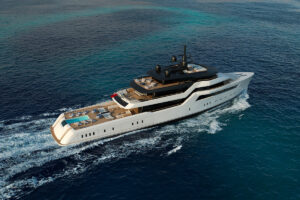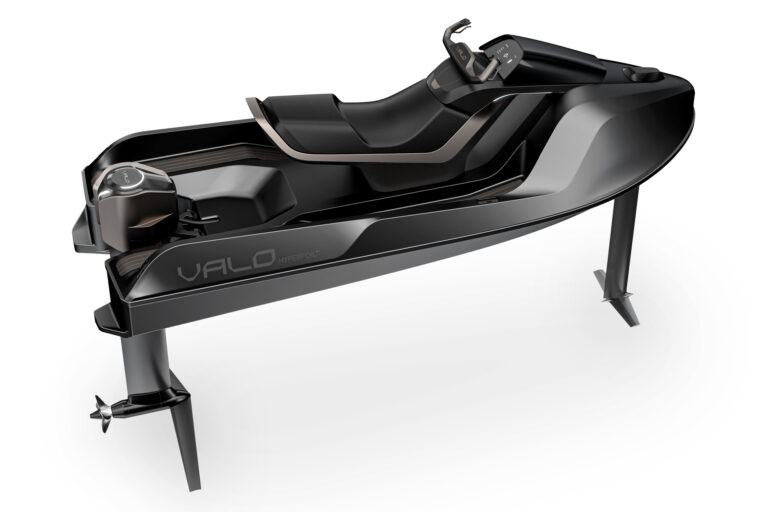Aficionados of fine diamonds consider the four C’s in purchase decisions. Azimut designated its new motoryacht “Carat with one of the C’s in mind, but I found the cut, color and clarity of this 80-foot fiberglass jewel equally telling in appreciating her value. Like any fine gem, she is not flawless but comes very close.
The Azimut 80 Carat is an open and largely informal family yacht, a trait she shares with other models in the Azimut line. Her informality does not imply any lack of quality in her finish, however. Cherry bulkheads, cabinetry and overhead accents are highly detailed, well fitted and finished in high-gloss lacquer that twinkles with clear reflections of recessed overhead lights.
Upholstered furniture, soft bulkhead panels and dramatically shaped overheads are in neutral hues that nicely complement the woodwork. Most countertops are marble or granite. The master head sole is marble, while wood is used in other heads. The sole of the in-line galley is a sensible nonslip patterned rubber that will be easy to clean and comfortable on the feet.
The Carat’s profile, from the talented hand of stylist Stephano Righini, identifies her as a sister to other Azimut yachts, both larger and smaller. Yet unlike Azimuts that have a large, continuous oval pattern in the deckhouse window, the Carat’s window is divided by a sizable “dorsal fin post. It eases the earlier look’s boldness and blends nicely into the curves of the pilothouse and flying bridge.
This boat’s size puts her on the cusp of that point between owner-operated and crewed yacht, maybe a little past it. Only the most capable family will want to cruise her alone. Most will carry at least a captain, perhaps a mate, too. Though the 80 is primarily a production yacht, Azimut offers an option on the crew arrangement. The standard version has crew’s quarters with upper-and-lower single berths and a small mess. The optional American arrangement replaces the mess with a double berth and hanging locker for the captain, allowing space for a chef/steward in the second single if desired.
On yachts this length, the basic question is always the same: four comfortable staterooms, or three that are a bit more lavish? The Carat opts for four and does not offer an alternative, but her eight guests will not suffer.
The full-beam master is near amidships, where pitch will be minimal. The master is separated from the engineroom by the crew’s quarters, but during our trials, there was little perceptible vibration on the afterdeck and none inside the yacht. The master has a vanity and a large walk-in locker to port, and a comfortable settee to starboard. The head includes a spacious shower, a bidet and two sinks.
VIP guests are accommodated in a bow stateroom with an island queen berth. The remaining four guests occupy two twin-berth cabins, port and starboard between the master and VIP staterooms. Though more compact, the twin cabins are finished and outfitted as nicely as the two main staterooms. For example, the VIP and twin cabins have nearly identical heads: All have circular showers with water outlets overhead that provide the rain-showering equivalent of surround sound. Curved acrylic shower doors rotate out of the way when not in use, allowing extra floor space in front of the toilet and sink.
The Carat’s second option in arrangement comes in the dining area on the main deck’s starboard side. The standard layout includes an oval dining table surrounded by eight chairs, while the American version replaces the five outboard chairs with a large banquette. Both have a compact galley to port, facing the table. A beautifully built tambour panel lets the galley remain open as a buffet for informal dinners and cocktail parties. During more formal meals, the panel can be closed for privacy.
A lower helm is forward of the galley. Aft, the saloon has fixed seating on two settees facing an entertainment center in the after corner of the room. Like many yachts, the Carat has a power sliding glass door in a glass bulkhead aft, but unlike many other such doors, Azimut’s is weathertight. It includes an innovative system that offsets as it closes, sealing tightly against a gasket.
I was less impressed, however, by a pantograph door in the house side opposite the lower helm. While the pantograph door is solidly built, operates easily and seals tightly, it opens inward rather than outward. A stainless-steel drip tray is provided in the deckhouse sole to catch water running off the door’s exterior surface when it is opened. In spite of assurances from Azimut’s captain that the company has never had overflow problems, I’d still like to see it arranged otherwise.
The afterdeck is spacious and fully protected from sun and rain by the extended flying-bridge deck above. Full-length side decks and aft mooring stations with raised capstans, cleats and roller fairleads make docking a snap.
A single stairway leads to an integral swim platform. In port or at anchor, a transom door provides entry to the engineroom and, through it, access to the crew’s quarters. Stern stowage lockers large enough for personal watercraft flank the door.
Accessibility in the engineroom is good outboard of the engines, excellent in all other areas. I was happy to see emergency fire dampers on the ventilation ducts and a structural cage around the V-drive shaft, safety features too often omitted.
The flying-bridge deck is huge. Even with a tender stowed aft and a large sunpad, there is still plenty of room for socializing. The driver’s pod at the centerline helm has enough space for a companion on either side. Abaft it, curved settees flank a small table with what Azimut calls a perimeter leaf. This expands the table by wrapping around, rather than inserting in, the smaller top.
In addition to an open aft stair, an innovative alternating-tread wood stair accesses the flying bridge from the galley. Steeper than most stairs to preserve space, it has footpads rather than full-width treads. It is a clever design that has proved safer than inclined ladders in applications afloat and ashore.
Testing the Carat in the azure waters off Azimut’s home port of Viareggio, Italy, I got a good feel for the hull’s performance. She tracked true and was good in turns, with moderate inboard banking, little loss of speed and no noticeable bow drop. The ride was easy with no pounding or slap, and inside, the boat was quiet enough for normal conversation at the helm.
Encountering a combination of swells and small chop was not the same as running in heavy weather, but the Carat’s V-hull with a fine entry and 10 degrees of deadrise at the transom should take on the seas with the same ease I’ve enjoyed on other Azimuts with similar hull forms.
Running the Carat from the lower helm, I found the instrument panel a bit high when I was seated. This was the first hull, though, and plans were under way to lower the console on subsequent boats. Otherwise, both lower and upper helms were excellent. Controls were straightforward and easy to operate, and response to the wheel and throttles was immediate and predictable.
We topped out at 32.4 knots at 2300 rpm, this boat being equipped with MTU 12V 2000 engines developing 1,500 hp each.
The Azimut 80 Carat’s combination of reliable composite construction, interior and exterior comfort, smart yet subdued styling and excellent performance make her a jewel worthy of consideration. She is suitable for formal or informal entertaining, day-tripping or extended cruising.
Contact: Azimut, (011) 39 011 93161; fax (011) 39 011 9316677; www.azimutyachts.net.








